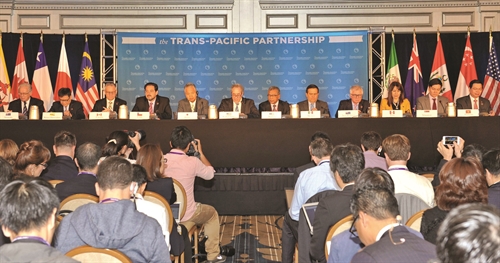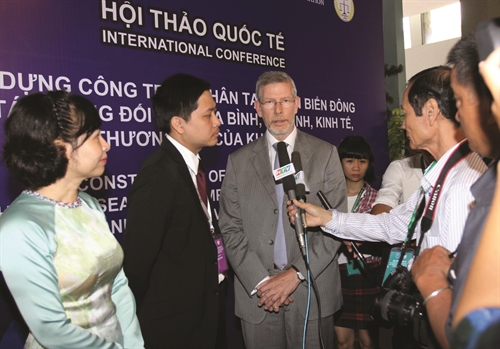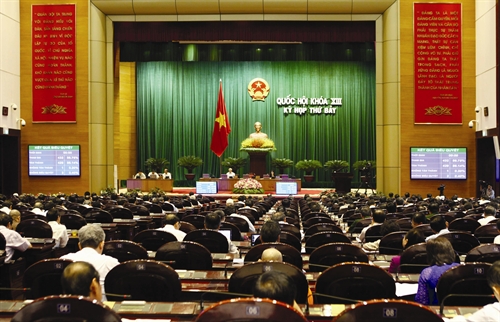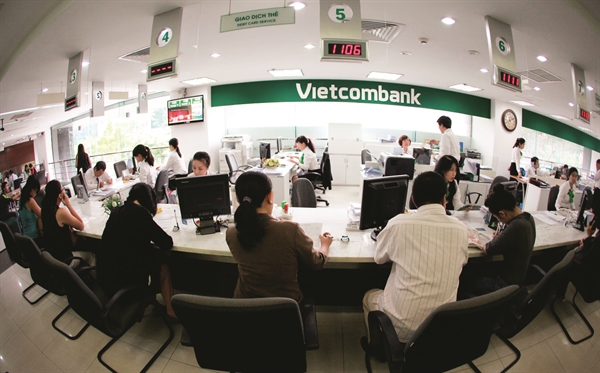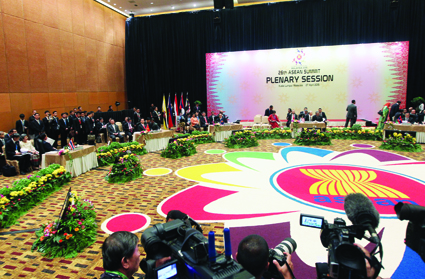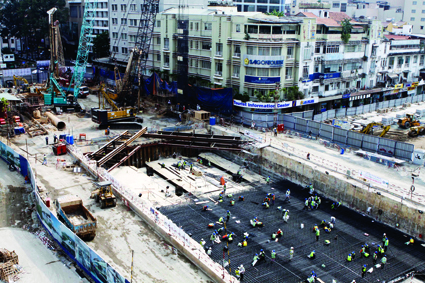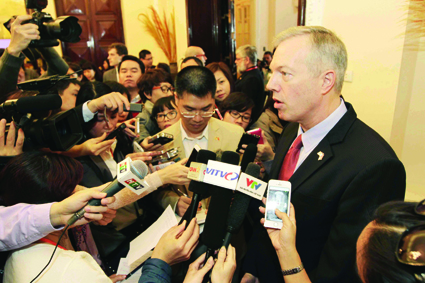Sandeep Mahajan
Lead Economist, World Bank
Motivated by a strong record of success and energized by the aspirations of a rising middle-class society, Vietnam is now aspiring to an ambitious future. The country’s ambitions are aptly captured in its constitution, which sets the objective of a “prosperous people and a strong, democratic, equitable and civilized country.” There is a firm aspiration that by 2035, Vietnam will be a modern and industrialized nation, offering a higher quality of life to its people. The aspirations reflect an emphasis not just on higher incomes, but equally on clean water and clear blue skies, a healthy, secure, learned and equitable society, and an effective state accountable for improving material welfare. Motivated by these aspirations, the Government of Vietnam and the World Bank Group have jointly prepared the Vietnam 2035: Toward Prosperity, Creativity, Equity, and Democracy report, the overview of which was recently released. The report gives further shape to Vietnam’s aspirations, highlights the key development challenges that remain, and outlines a series of policy recommendations to help Vietnam achieve its 2035 goals.
A record of strong and equitable growth
Vietnam is a major development success story. Less than three decades after the start of the Đổi Mới reforms, the country has built up an impressive record of strong economic growth that has also been equitable and stable. GDP growth per capita has averaged 5.5 percent a year since 1990, yielding a three-and-a-half-fold increase in average income. Only China performed better. Growth has benefited from its remarkable stability and a strong external orientation of the economy. External trade has been a major driver, much of it powered by strong foreign direct investment, with the stocks standing at more than USD250 billion, sourced from a diverse group of more than 100 countries. And growth has been inclusive, as seen in a fairly small increase in the Gini coefficient and the faster income growth of the bottom 40 percent. As a result, poverty has fallen rapidly.
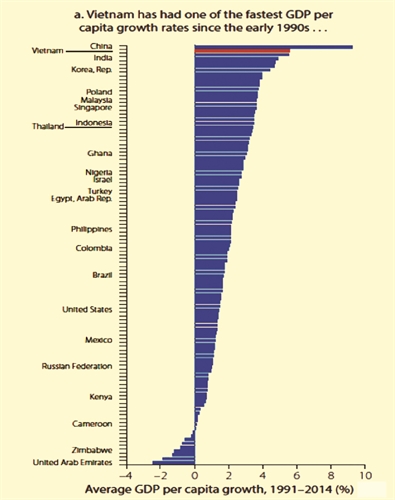 |
 |
 |
 |
 |
 |
Vietnam today is an unrecognizably transformed, dynamic, middle-income economy. Social outcomes have improved dramatically across the board. Using a variety of international and national poverty lines, poverty has fallen rapidly since the launch of Đổi Mới. The USD1.9-a-day poverty rate fell from 50 percent in the early 1990s to 3 percent today. Not only are incomes higher, the Vietnamese population is better educated and has a higher life expectancy than most countries at a similar per capita income. In recent international tests Vietnamese students outperformed the average for countries in the Organization for Economic Co-operation and Development (OECD), with remarkably little variation across income groups and urban-rural locations. The maternal mortality ratio has fallen below the upper middle-income country average, while under-five mortality has fallen by half, to a rate slightly above that average. Access to basic infrastructure has also improved substantially. Electricity is now available to almost all households, up from less than half in 1993. Access to clean water and modern sanitation has risen from less than 50 percent of all households to more than 75 percent.
Key development challenges
In some areas, however, Vietnam’s development progress has fallen short. Labor productivity (output per worker) growth has been on a declining trend since the end of the 1990s, seen across most industrial subsectors, as well as in mining, finance and real estate. In agriculture, labor productivity has grown robustly, but its level is still lower than in most of the region’s middle-income countries. With almost half the workforce still engaged in agriculture, Vietnam has too many workers on its farms. Remedies include consolidating agricultural landholdings (which are too fragmented and small) and moving farmers to the more productive industry and service sectors. But it does not help that job creation in manufacturing has plateaued at a relatively low level and that services involve mostly informal activity.
Labor productivity growth has been on a declining trend since the late 1990s
 |
Although Vietnam has avoided the large increases in inequality in other fast-growing countries, significant groups remain marginalized, and the gaps in opportunity for children are wide between poor and wealthy households. While members of ethnic minorities have experienced gains in welfare since the early 1990s, they face a growing gap relative to the majority population. With 15 percent of the population, they now make up half the poor. And in recent years, progress for ethnic minorities has stalled on poverty reduction, child mortality and nutrition. More than half the children with severe disabilities never attend school. At least 5 million urban migrants lack permanent registration in their place of residence and thus have limited access to public services, including schooling and health care. And, with 114 boys born for every 100 girls, the sex ratio at birth in Vietnam has become one of the most imbalanced in the world, reflecting a major gender gap in the society.
Ethnic minority children face higher inequality of opportunity
 |
Growth has to a significant extent come at the cost of the environment. Vietnam’s greenhouse gas emissions have grown the fastest in the region, while the environmental quality of its air, land and water has deteriorated considerably. Water and air pollution have reached serious levels, especially near Hanoi and Ho Chi Minh City, posing major health risks. In addition, a large part of Vietnam’s protective mangrove forests has been destroyed, while overfishing has seriously depleted the nearshore fisheries, posing threats to livelihoods. Removing natural forests in some upland areas has contributed to more frequent and severe flooding of lower altitude farms and human settlements. Finally, Vietnam is one of the world’s most vulnerable countries to climate change, with adaptation challenges accordingly severe, especially in the Mekong Delta. With almost all large-scale hydropower potential tapped and with limited development of other renewable sources, greater reliance on coal is a growing threat to environmental sustainability and to energy security.
Last but not least, Vietnamese institutions have not kept pace with the needs of an increasingly demanding market economy and rising aspirations of a growing middle-class society. In particular, the country’s unique history has produced public-sector institutions that are commercialized and vertically and horizontally fragmented and that face insufficient scrutiny by citizens. Despite reforms, the state is still strongly engaged in economic activity - directly through SOEs and indirectly through very close links with an exclusive segment of the domestic private sector. State fragmentation arises from the lack of clear hierarchy and assignment of roles and responsibilities both within the central government and between the center and the provinces. The absence of a merit-based management of public servants exacerbates the gaps in public institutions. Election processes and mechanisms for engaging citizen organizations are not robust enough to provide true citizen representation, and Vietnam lacks a system of effective checks and balances between the three branches of government.
Vietnam ranks poorly on some key indicators of governance (Worldwide Governance Indicators)
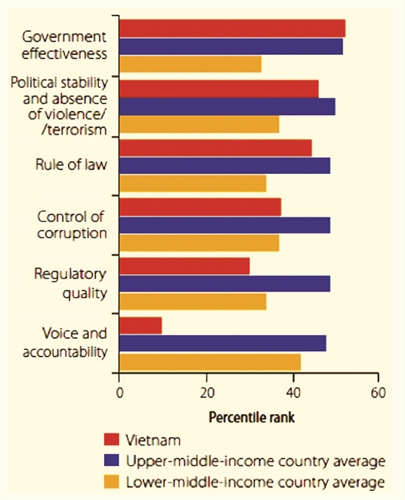 |
Aspirations for 2035
By 2035, 60 years after reunification, Vietnam aspires to become a modern, industrialized economy-next in a succession of East Asian economies to have made the transformative journey to upper-middle or high-income status. The many achievements since the launch of the Đổi Mới reforms have certainly contributed to the ambitious goals. The strong record of regional peers such as the Republic of Korea, Singapore, Malaysia, China, and Taiwan, China-together with the fear of being permanently left behind in the region-has further fueled Vietnam’s ambitions. There is still an inherent desire to “catch up” with the world and the modern institutional norms of OECD countries for living standards, the rule of law, and creativity, as reflected in the broad aspirations for 2035. Vietnam has also signed up to the UN’s Sustainable Development Goals (SDGs), which set a comprehensive global development agenda for the next 15 years and will give more concrete shape to some of Vietnam’s key long-term goals.
Vietnam’s aspirations for 2035 may be broadly defined in the following ways:
- A prosperous society that will be at the upper reaches of upper-middle-income status. Its market economy will be private sector-led, competitive and intensively integrated with the global economy. Modern industries and a knowledge-based economy, housed in an efficient and well-connected network of modern cities, will drive growth.
- A modern, creative and democratic society will be the driving force for future development. The emphasis will be on creating an open and free environment that promotes learning and innovation for all citizens, who will be guaranteed equal access to development opportunities and the freedom to pursue their vocations, while fulfilling their responsibilities without compromising national and communal interests.
- A rule-of-law state will be effective and accountable. It will clarify the relationship between the state and the citizenry and between state and market. It will perform its basic functions effectively, including developing and enforcing legislation; managing international relations; ensuring public safety and national security; and ensuring that markets function freely while addressing market failures. It will develop strong social institutions to ensure that the power belongs to the Vietnamese citizens and protect their right of pursuing creativity. It will develop clear lines of responsibilities between the legislative, judiciary and executive branches for adequate checks and balances on the government.
- The National Assembly will comprise full-time deputies with the technical capacity and institutional autonomy to represent the sovereign people, exercise oversight over the executive and pass quality legislation. The judiciary will similarly be suitably positioned, with autonomy and strong capacity to resolve disputes in a more diverse society and economy. The executive will be well integrated horizontally and vertically, with clear functions for central and subnational authorities.
- A civilized society will make every citizen and every political and social organization (the entire political system) equal before the law. Underpinning this will be robust, diverse people’s social organizations that can exercise fundamental rights, including the people’s direct democratic rights and the rights to information and association.
- A responsible member of the global community of nations will build global alliances and fulfill global responsibilities for peace and security while proactively seeking regional and global opportunities for economic integration.
- A sustainable environment will protect the quality of Vietnam’s air, land, and water. It will build climate resilience into economic planning, social policy and infrastructure investments to reduce the most severe risks posed by climate change. It will develop diverse, clean and secure energy sources.
Achieving these aspirations will require bold and decisive action, both to grasp the opportunities and to manage risks. The notable opportunities are an emergent and increasingly urban domestic middle class, proximity to a rapidly rising China, and megaregional trading agreements-particularly the Trans-Pacific Partnership (TPP), in which Vietnam is the only lower-middle-income member. The major risks are the rapid aging of the population, the less hospitable global economy, and the threat of climate change, to which Vietnam is heavily exposed. Global technological and business innovations, powered by the information revolution, will remain disruptive-presenting more opportunities and risks, with Vietnam’s net benefits depending on its responses.
Policy and institutional reform agenda for achieving Vietnam’s 2035 aspirations
Vietnam’s aspirations and the supporting policy and institutional agenda stand on three pillars: balancing economic prosperity with environmental sustainability; promoting equity and social inclusion; and boosting the state’s capacity and effectiveness.
Balancing economic prosperity and environmental sustainability
The immediate emphasis has to be on ensuring more competitive and productive domestic enterprises, for which development of critical market institutions is important. Particular attention is needed to the institutions that protect private property rights and enforce competition policies. A stable, well-regulated and inclusive financial sector and transparent and functioning land markets will also be crucial. And as the country embarks on an ambitious growth and economic modernization trajectory, its cities will need to better nurture private enterprise and innovation, support the growth of industrial clusters integrated with global value chains, and attract and agglomerate talent. Sustaining high growth over an extended period will also require an aggressive agenda to spur learning and innovation. An incentive-based national innovation system, focusing on the demand for and supply of innovation, can be very useful in this regard. Finally, Vietnam has to protect its natural resources, tap more clean energy sources and build climate resilience into economic planning, sectoral policies, and infrastructure investments so as to reduce the most severe risks posed by climate change.
Promoting equity and social inclusion
The main elements of the middle-class and aging population agenda are expanding the pension system to cover a majority of the population, ensuring that nearly all children complete upper secondary school with job-relevant skills, establishing effective representation of workers through independent unions, and achieving universal health coverage. In addition, targeted initiatives in education, nutrition, and sanitation can close the large gaps in opportunities for ethnic minority children, along with giving them more voice. To make people with disabilities full participants in society, Vietnam can regularly monitor implementation of its strong commitments and create opportunities for people with disabilities and their families to be their own advocates through social organizations. Eliminating the link between the residence registration system and access to public services (currently affecting 5 million people) will improve urban migrants’ access to schooling, health care and administrative services. And minimizing gender discrimination in the retirement age and using affirmative action as a short-term measure will create more opportunities for women in public leadership roles.
Boosting the state’s capacity and accountability
Today’s stagnant productivity and weak environment for private-sector development are attributable to demonstrable gaps in state effectiveness. Vietnam’s unique history has produced public sector institutions that are commercialized and fragmented and that face insufficient scrutiny by citizens. Efforts to address these issues will build more coherent government structures and a stronger, more meritocratic bureaucracy. Market rationality can be applied more to economic policy making by clearly demarcating the public and private spheres, implementing conflict of interest provisions, enhancing the security of property rights (particularly around land issues), enforcing market competition, and streamlining state participation in the economy. And public accountability can be increased by allowing for genuine checks and balances among the three branches of government, providing a legal framework to promote the rights of citizens and improve their access to accurate and timely information, and assuring a stronger role for mass media.
Vietnam is at a turning point on its development path. There are tremendous opportunities on offer, as well as major challenges. To achieve the 2035 vision, the only viable choice is for the country to carry out a bold program of reforms that is consistent with the mentioned three pillars. Without this, Vietnam will find it very hard to avoid the “middle-income trap” and will fall well short of its significant potential. The Vietnamese people have the strong will, the spirit, and the capacity to implement the reform agenda successfully and to move toward a prosperous, creative, equitable and democratic Vietnam.-



